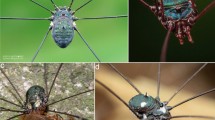Summary
Marthasterias glacialis bears two kinds of pedicellariae. The straight pedicellariae are single and occur everywhere on the asteroid body surface except in the ambulacral groove. The crossed pedicellariae are clustered on mobile structures (the rosettes) build around marginal and abactinal spines.
Basically, each pedicellaria has a head and a stalk. A skeleton occurs only in the pedicellarial head. It consists of two valves and a basal piece. Muscular bundles are anchored on these skeletal ossicles. The straight pedicellariae have two pairs of adductor muscles (the inner and the outer adductors) and one pair of abductor muscles, these latter being weakly developed. Longitudinal muscle fibers occur all along the stalk of straight pedicellariae. The crossed pedicellariae have two pairs of adductor muscles (the distal and the proximal adductors) and two pairs of abductor muscles (the distal and the proximal abductors). The proximal adductors of crossed pedicellariae are homologous to the stalk muscles of straight pedicellariae.
The pedicellariae are able to react to direct and indirect tactile stimuli. There is a great deal of individual variation among pedicellarial responses. Moreover, the reactions occur at random and lack coordination. The seemingly aberrant behavior of the pedicellariae is interpreted as a preventive activity that protects the asteroid body surface against unwanted materials and organisms.
Similar content being viewed by others
References
Barel CDN, Kramers PGN (1977) A survey of the echinoderm associates of the north-east Atlantic area. Zool Verhand Leiden 156:1–159
Campbell AC (1972) The form and function of the skeleton in pedicellariae from Echinus esculentus L. Tissue Cell 4:647–661
Campbell AC (1983) Form and function of pedicellariae: A review. Echinoderm Stud 1:139–167
Chia FS, Amerongen H (1975) On the prey-catching pedicellariae of a starfish, Stylasterias forreri (de Loriol). Can J Zool 53:748–755
Fisher WK (1906) The starfishes of the Hawaiian Islands. Bull US Fish Comm 190:987–1130
Fisher WK (1919) Starfishes of the Philippine seas and adjacent waters. Bull US Natn Mus 100 (3):1–172
Ganter P, Jollès G (1969–1970) Histochimie normale et pathologique. 2 vols Gauthier Villars: Paris
Hilgers H, Splechtna H (1976) Struktur und Funktionsanalyse ophiocephalen Pedizellarien von Sphaerechinus granularis (Lam.), Echinus acutus Lam. und Paracentrotus lividus (Lam.) (Echinodermata; Echinoidea). Zoomorphologie 86:61–80
Hyman LM (1955) Echinodermata. In, The Invertebrates, Vol 4 736 pp Mac Graw Hill Publ: New York
Jennings HS (1907) Behaviour of the starfish, Asterias forreri de Loriol. Publ Zool Univ California 4 (2):59–82
Nichols D (1962) Echinoderms. Hutchinson University Library, London
Smith JE (1937) On the nervous system of the starfish, Marthasterias glacialis (L). Phil Trans R Soc Lond (B) 227:111–173
Author information
Authors and Affiliations
Rights and permissions
About this article
Cite this article
Lambert, A., De Vos, L. & Jangoux, M. Functional morphology of the pedicellariae of the asteroid Marthasterias glacialis (Echinodermata). Zoomorphology 104, 122–130 (1984). https://doi.org/10.1007/BF00312026
Received:
Issue Date:
DOI: https://doi.org/10.1007/BF00312026




